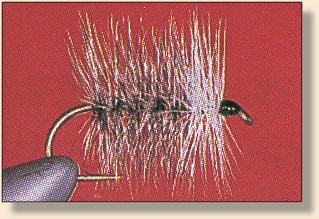
 |
|
Grizzly Bivisible
|
 Step 5. Pick up the feather and start wrapping. If you're using one of those long, good-quality saddle hackle, you won't need hackle pliers. Each turn should lie contiguous to the one before. Be sure to keep the pretty side of the feather facing forward; this is very important. If you're wrapping by hand and the feather becomes too short to grip comfortably, attach your hackle pliers and continue. Ain't dry-fly hackling fun?
 Step 6. When you reach the thread, tie off the feather. If you have good, stout hackle pliers, you may wish to use them now - whether or not you used them in the wrappings - as they'll help you tie off hackle feathers. Clamp them onto the feather as shown, and let their weight maintain tension on the quill. Work the thread in among the barbs and take four or five very firm thread wraps behind the feather to bind the quill to the hook shank. Try not to tie down any barbs if you can help it.
 Step 7. Trim off the rest of the feather by cutting the quill. If there's enough feather left for additional flies, do this carefully. With today's saddles, it's not uncommon to get several flies from a single feather. Step 8. Select a white feather with the same length of barb as the main hackle feathers. It can be either a cape or saddle feather. Prepare it exactly as you did the grizzly, and tie it in beneath the hook shank in suck a position that the first turn will abut the last turn of the grizzly. Remember: pretty-side forward, and keep a tiny length of quill exposed.
 Step 9. Advance the thread to the eye, then back two or three turns. Wrap the hackle forward as you've been doing and, when you reach the thread, tie it off as you did the first hackle, and trim the excess. Secure it with a few firm housekeeping wraps, whip-finish, and lacquer. ~ Dick Talleur Credits: This fly is an excerpt from Basic Fly Tying, published by the Lyons Press which was previously reviewed here.
|
|
|
[ HOME ]
[ Search ] [ Contact FAOL ] [ Media Kit ]


